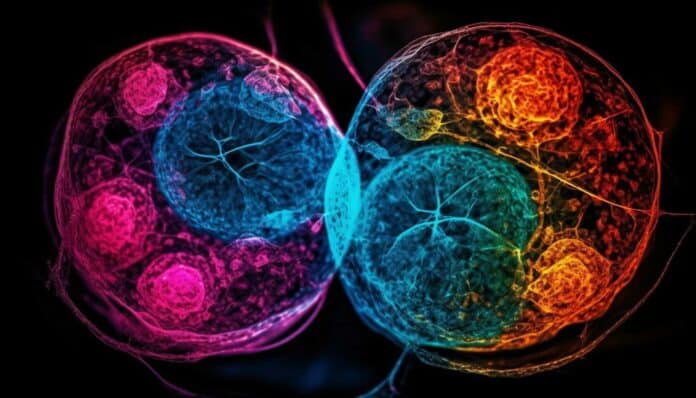Loss of heterochromatin and genetic instability play a role in cancer progression by promoting clonal diversity. However, excessive replicative stress can lead to mitotic catastrophe and trigger inflammatory responses, which in turn can lead to immune rejection of cancer cells.
KRAB domain-containing zinc finger proteins (KZFP) help maintain heterochromatin at transposable elements (TE), contributing to genomic stability.
In a new study, EPFL scientists identified an association of upregulation of a cluster of primate-specific KZFPs with poor prognosis, increased copy-number alterations, and changes in the tumor microenvironment in diffuse large B-cell lymphoma (DLBCL). They uncovered how cancer cells use certain proteins to shield themselves from immune attacks, offering new treatment perspectives with immediate application.
Led by the group of Didier Trono at EPFL, the study uncovered a significant strategy used by cancer cells. In particular, scientists identified a group of proteins called “KRAB zinc finger proteins” (KZFPs). These proteins help cancer cells manage genetic stability and avoid immune system detection.
KZFPs act like supervisors inside our cells, controlling which parts of our DNA are active or inactive. Some KZFPs specifically target repetitive DNA sequences called transposable elements (TEs), which comprise a large portion of our genome. If TEs become active, they can cause genetic instability, threatening the cell’s health and immune detection. KZFPs help keep TEs silent within heterochromatin, a tightly packed DNA structure, thereby protecting the stability of our genome.
In a recent study led by Filipe Martins, a scientist in Trono’s group, researchers found a link between certain primate-specific KZFPs and the prognosis of Diffuse Large B Cell Lymphoma (DLBCL), a type of cancer. They investigated the effects of reducing two specific KZFPs in tumor cells from various cancers, including DLBCL, using advanced cell culture techniques and genetic manipulation methods.
The scientists focused on two proteins, ZNF587 and ZNF417 because they’re linked to a poor prognosis in Diffuse Large B Cell Lymphoma (DLBCL). These proteins also target newer transposable elements in our DNA, which are connected to maintaining genomic stability and helping cancer cells evade the immune system.
When ZNF587 and ZNF417 were removed from DLBCL cells, it caused significant disruptions in how the cells functioned. Their absence led to changes in how heterochromatin, a tightly packed DNA structure, was distributed. This change caused replicative stress, which slows down or stops DNA replication and cell division.
This stress triggered an inflammatory response, making the cancer cells more visible to the immune system. Without ZNF587 and ZNF417, the cancer cells displayed more diverse neoantigens, which alert the immune system to attack them.
Didier Trono said, “Our study shows that TE regulation and heterochromatin maintenance by KZFPs is essential also in cancer, which allowed us to uncover new functions of KZFPs, previously overlooked in cancer research due to their young evolutionary age and presumed redundancy.”
“Three-quarters of KZFP genes are primate-restricted, challenging the conventional wisdom that the more conserved a protein is, the more essential it should be for cancer development. Our findings indicate that KZFPs regulate gene expression and participate in DNA replication and genome stability, which can influence the genetic diversity and occurrence of subclonal populations of cancer cells, thus playing a pro-oncogenic role.”
“This DNA damage and ‘viral mimicry’ of TEs due to their upregulation led to the activation of cell-intrinsic inflammatory pathways promoting immune rejection in vitro,” adds Filipe Martins. “These phenomena have so far been seen only with chemotherapy agents or depletion of cellular enzymes. Therefore, targeting transcription factors holds the promise of a potential immunogenic chemotherapy-like effect.”
“The findings suggest that cancer cells may exploit these proteins to temper their visibility to immune surveillance. It is a true conceptual breakthrough. Transposable elements, which most consider only as genetic threats, were revealed to be sentinels against loss of epigenetic controls, and their KZFPs regulators were shown to be subverted by cancer cells to escape this surveillance.”
“The findings also highlight potential new targets for therapy of Diffuse Large B Cell Lymphoma. The discovery points immediately to novel therapeutic avenues for this disease. It is a line of research for which we are currently raising funds for a large consortium comprising several groups from EPFL in addition to others from Stanford, the Curie Institute, Cornell, the van Andel Institute and London’s Bart Institute, and we are also working towards the launching of a startup.”
Journal Reference:
- Filipe Martins, Olga Rosspopoff, Joana Carlevaro-Fita, Romain Forey, Sandra Offner, Evarist Planet, Cyril Pulver, HuiSong Pak, Florian Huber, Justine Michaux, Michal Bassani-Sternberg, Priscilla Turelli, Didier Trono. A cluster of evolutionarily recent KRAB zinc finger proteins protects cancer cells from replicative stress-induced immunogenic inflammation. Cancer Research. DOI: 10.1158/0008-5472.CAN-23-1237
